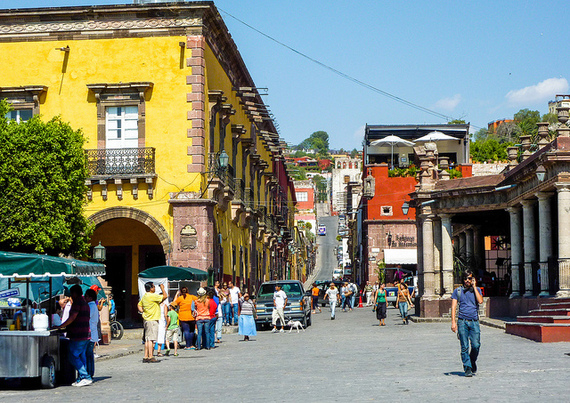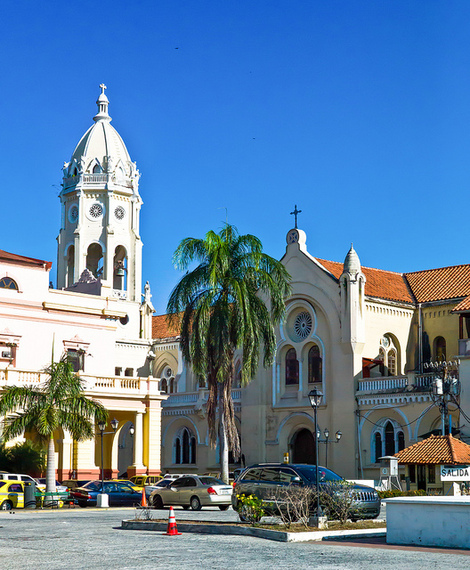One of the best things for a vacationing food-lover to do is to set an early alarm, roll out of bed and visit a great market like the Boqueria in Barcelona, Tsukiji in Tokyo or the Rialto market in Venice. It is also one of the most frustrating: As a transient, you can't buy a pound of those tiny live shrimp or a basketful of those purple artichokes and take them home to cook unless you're staying in an apartment rather than a hotel. And, for Jackie and me, the pleasures of a great hotel are just too alluring to miss, so we've always had to play the role of marketplace gawkers.
During a November trip to Venice we finally got to buy our shrimp and eat them too, thanks to classes offered by the Epicurean School at the luxurious Gritti Palace hotel. The school goes back to 1975, and the hotel's recent top-to-bottom renovation revived it with a beautifully equipped new space for demonstrations and hands-on classes, which includes a comfortable rustic-chic dining room for post-class lunch and other activities such as wine events and informal private dining.
We were signed up for a half-day class (shorter three-hour sessions are also offered, as are longer programs stretching over several days) whose "syllabus" included a shopping expedition to the Rialto market, a mid-morning snack near the market, a cooking demonstration/lesson and a late lunch. Our cicerone was Daniele Turco, the hotel's personable executive chef, who shares these teaching duties with two colleagues (yes, they all speak English).
On all previous visits to Venice, Jackie and I been to the Rialto market - which has its roots in the eleventh century and which specializes in seafood, fruit and vegetables, though there are a few butchers' shops too - so we had a sense of what gorgeous things we'd find there. Discussing them with someone in the know was an exciting prospect: I was looking forward to this so eagerly that I feared I'd be disappointed, an entirely unfounded anxiety as it turned out.
Shopping
We met Mr. Turco not at 5:30 in the morning (as for our visit to Tsukiji a few years ago), but at the more palatable post-breakfast hour of 9:30, then walked to the market, umbrellas at the ready but not needed for the quarter-hour amble. Being there with someone like Mr. Turco was as interesting and lively as you'd imagine: as we looked at (beautiful) vegetables, he talked about the various places (mostly in Italy) they come from at different times of the year, something that would otherwise have remained a mystery. We bought artichokes and I asked about the speed and skill with which market workers are able to trim them; so after we'd finished shopping, he escorted us to one of the hotel's vegetable suppliers, who gave us a demonstration of how to reduce a globe artichoke to a perfect ready-to-cook artichoke bottom in a matter of seconds.
There are a few butcher shops on the periphery of the market, where we saw something new to me: ham-like legs of mutton labeled Castradina. Mr. Turco explained that they are eaten on exactly one day a year, November 21, the feast of Santa Maria della Salute (Our Lady of Deliverance), to commemorate deliverance from a plague in the seventeenth century; the mutton is spiced and salted, smoked and dry cured according to a Croatian recipe (look at the map and you'll see that this isn't as strange as it sounds), and it is invariably made into a soupy stew with Savoy cabbage. These food traditions remain strong even in the face of a growing taste for fast food (less evident in Venice than in other major cities).
But the real excitement came when we reached the seafood. The night before, a pushy waiter had tried to convince us that the highly prized gray shrimps known as
schie were "more or less" in season; we didn't believe him and ordered other dishes. At the market, we saw for ourselves that there were hardly any of them; Mr. Turco pointed out just a few fortuitously mixed in with other species: there were precisely two among the scoopful of live pink shrimp we bought; we also bought
moeche, the smallest soft-shell crabs I've ever seen, their bodies little more than an inch across, and also very much alive.
There was so much that would have remained a mystery if we'd been alone: What ever are those slim foot-long pink-fleshed fish, skinned up to the base of the head? The sign says
Palombo, which doesn't really help. Mr. Turco explained that it's a type of shark - always sold in that way since the skin is very tough, and commonly but not solely used in a soup believed to be health-giving. Why is that turbot called a
rombo chiodato? Here, feel it: the sharp protrusions on the skin are like nails (
chiodi). We saw razor clams a third of the size of the ones sold elsewhere (which Venetians find monstrously big). We saw so many varieties and sizes of squid, cuttlefish and octopus in inky tangles. We saw big spider crabs and little eels (big ones too). And we heard what a Venetian cook would do with many of these things: For example, small (but not the tiniest) octopuses are sometimes cooked without emptying their heads and are served with a celery salad - I'd eaten this in a restaurant and thought that the heads had been stuffed with an anchovy mixture they were so flavorful. Just before leaving, Mr. Turco bought a gape-mouthed bass, stiff with rigor mortis - it could have been fresher only if still swimming.
Snacking
On the way back with our purchases, we stopped for a second breakfast of delicious snacks - cicchetti - and a glass of prosecco. The bar - all'Arco (Sestiere San Polo, 436; +39 041 520 5666) - was notable for the quality of its food and the seriousness with which it was prepared. Talking about fish
in saor (an indispensable Venetian dish of fish - most typically sardines - fried and marinated with fried onions, vinegar, raisins and, generally, pine nuts), the man behind the counter explained that different fish take on the flavors of the marinade at different rates: some can be eaten a day after they are made, while others must be held for a few days before serving. This kind of wisdom isn't in recipe books.
On the walk back to the Gritti Palace I quizzed Mr. Turco about traditional dishes like
bigoli in salsa, another icon of Venetian cooking. His view was that the simplest recipe is the best; you can read about it in my
Cooking Off the Cuff column of a couple of weeks ago.
Cooking
After a quarter hour's break for Mr. Turco to change into his work clothes - white jacket and apron - we met in the school kitchen and got to work. In fact, Mr. Turco did almost all the cooking: without the distraction of too many cooking tasks apart from picking spider-crab meat, shelling shrimp and trimming purple artichokes, we were able to concentrate on the details of what was going on.
The plan was to use our purchases to cook a three-course lunch of assorted antipasti/cicchetti, an artichoke risotto and sea bass. I was particularly eager to see how a local cook made polenta and risotto (what I learned about the latter I wrote about
last week). Venetian polenta is very loose, very white and, some would say, very bland. Mr. Turco used lots of water, a tiny bit of salt and fine polenta milled from a regional heirloom variety of corn, biancoperla; at home, Anson Mills's white polenta, from an American heirloom variety, was a perfect substitute. The revelation here was that once the loose gruel was simmering, it didn't need to be stirred all that much: kept loosely covered over very low heat, stirred occasionally and with the addition of a little water if needed, it would hold for hours once it was cooked. It's easy, and it works; the mild flavor provides a perfect background, especially, for lighter seafood dishes (with braised beef, say, I'd probably opt for a heartier more heavily seasoned polenta).
For the risotto, small purple artichokes were prepared in two ways. After trimming, the hearts were finely sliced. Most were sautéed in olive oil until almost done; they'd be added to the risotto for the last couple of minutes of cooking time. The rest were held in water acidulated with lemon juice, then barely drained, dredged in flour and deep fried as a topping. My instinct would have been to drain them more thoroughly before flouring, but the moisture ensured that sufficient flour would adhere to create a coating that remained crisp.
One of our cicchetti was also floured and deep-fried: a couple of those tiny soft-shell crabs. Venetians leave them in beaten egg for some time before flouring them; there's a belief that the egg penetrates into the crabs. Mr. Turco doesn't believe that, but does it anyway, for tradition's sake. They were fried at moderate temperature - 330 degrees F (165 C) - which yielded some of the best soft-shells I've had, with crisp legs and edges and a very moist interior; almost like a fried dumpling with a semi-liquid center. They were served atop a spoonful of that soft polenta.
We also boiled those tiny shrimp in salted water with a bay leaf, then chilled and shelled them (very fiddly work for those of us used to the big shrimp we get in the US); these were dressed with a simple vinaigrette and spooned over a bed of julienned radicchio. I've adopted that idea for home too: Belgian endive (chicory) is a readily available substitute. A big spider crab then went into the same water for 20 minutes, and it too was chilled before being cracked and its meat picked. It was a female, and bore beautiful red roe tasting of the sea; this was used as a garnish for the crab meat, which was served on a bed of tiny greens.
Our main course was sea bass baked in a salt crust: not particularly Venetian, but in its simplicity an ideal way of showing off the perfection of the Rialto market's fish. Mr. Turco slipped herbs into the cavity, laid the fish on a bed of salt mixed with egg whites beaten to a stiff foam, then spread the top with more of the salt mixture. The blend of one third coarse and two thirds fine salt was something I hadn't seen before, and it gave the crust a texture that made it easy to handle when baked - as did the clever trick of incising a line around the fish that would demarcate an easily removed lid of salt crust. And when that lid came off, the clean herbal aroma was heady and the flesh impeccable.
The nice white wine we drank was made on the island of Sant'Erasmo in the Venice Lagoon; I'd had no idea that grapes or much of anything else was grown so near to Saint Mark's Square.
Mr. Turco was an excellent teacher; his technique was precise, his explanations clear and his answers to our wide-ranging questions satisfying and interesting. He was a good companion too - and he's a terrific cook. I'll always think of him as I stir a panful of risotto.
* * *
As to The Gritti Palace itself, it could hardly have been better as a luxurious, welcoming place to stay on the Grand Canal. The décor - lots of Murano glass, lots of marble, lots of everything - could seem just over the top anywhere but in a Venetian palazzo. In other words, it's just right. Service was quick, smiling and attentive in our room, at the bar (good drinks and elegant light meals) and at breakfast time, when that first desperately needed cup of coffee arrived pretty much instantaneously. Breakfast choices were good, too, with first-rate croissants and so forth (Italian style, not French, which is to say made with eggs and a little sweeter than you'd expect in Paris) and all the usual dairy products, meats and cheeses, plus a full menu of hot dishes. The hotel is particularly convenient: It is near a vaporetto (water bus) stop and there is a traghetto crossing just outside the door, which means you can take a gondola across the canal to Dorsoduro in seconds (€2 / $2.50), without a detour to the Accademia foot-bridge.
The best hotels are those you want to spend hours in even when touristic temptations beckon; we passed a great deal of time staring out our window across the water at Santa Maria della Salute and at the ever-changing boat traffic below. If the weather had been better, you'd certainly have found us hanging around on the canal-side terrace drinking Campari (not Aperol) spritzes.
The Gritti Palace Hotel. Campo Santa Maria del Giglio, Venice 30124; +39 041 794611;
http://www.thegrittipalace.com/; grittipalace@luxurycollection.com. Double rooms can start at around $480 out of season (which, believe me, is the best time to visit Venice); as with all Venetian hotels, the base price climbs as the tourist season advances: to about $850 by April and well into four figures by May.
The Gritti Palace Epicurean School. http://www.thegrittiepicureanschool.com/en/ Three-hour sessions with lunch cost €230 ($280) per person (usually a maximum of eight students per session - more than that is unwieldy); the half-day session we enjoyed costs €290 ($390) per person, including a market visit, drinks and snacks at a bacaro and the cooking and eating of lunch. All sessions are open to non-guests of the hotel.







































































